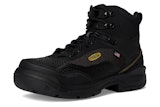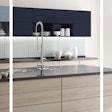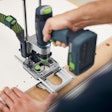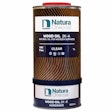
 Photo courtesy of The Francis Hotel
Photo courtesy of The Francis Hotel Photo courtesy of The Francis Hotel
Photo courtesy of The Francis Hotel Photo courtesy of Jack McInerny
Photo courtesy of Jack McInerny
Built in 1881 and known for its distinctive Victorian-era clock on its front lawn, the three-story brick structure had been shuttered for the past decade, and its antique slate roof had been leaking. Perhaps the worst part of the former funeral home’s dilapidated state was its wall-to-wall shag carpeting covering its original hardwood flooring.
“There was enough olive drab to make you sick,” McInerny recalls.
The developer was turning the historic building into The Francis, a luxury hotel named after its prolific Portland architect, Francis Fassett. Atlantic Hardwoods landed the restoration job via Wright-Ryan Construction, with which it has worked for 20 years.
Aside from the typical challenges that arise when restoring 137-year-old wood floors, the project also had a tight schedule—the building had been rented for a wedding reception in September, and restoration work began in July. So though the building’s famous clock stopped ticking decades ago, the construction teams had to pay close attention to the time.
“It was a lot of nights and weekends and working with an electrician on one side of me and a plumber on the other,” says McInerny of the accelerated job. “But sometimes the most challenging jobs are the most rewarding jobs.”
The Atlantic Hardwoods team spent a week doing demo work, purging the damp shag and particleboard and discovering a beautiful parlor of quartersawn white oak, mahogany and walnut on the first floor.
“I think back in the ’70s, they pretty much went wall-to-wall with whatever they could to cover up the floors rather than repair them,” McInerny says. The parlor's border had a few damaged elements that had to be replaced, which involved substantial time in the company’s woodshop fabricating small replacement pieces that were then glued in place.
About 80 percent of the 2¼-inch yellow birch flooring on the second floor of the building had suffered too much water damage to restore and had to be torn out.
While dealing with the water damage was a challenge, McInerny did manage to find the bright side: “In the areas that were just wet but not rotten, the moisture from the rain actually softened the [carpeting] adhesive, so a lot of it could be scraped up,” he says.
They replaced the damaged yellow birch with solid 2¼-inch-wide prefinished yellow birch that matched the original floor, nailing the new flooring over the plank and plywood substrate.
On the third level, which had been used as a storage space, 1,300 square feet of Douglas fir flooring was discovered virtually untouched, with no signs of ever having been sanded before, McInerny says.
Once the demo was complete and the damaged flooring replaced, the crew used a big machine to sand larger portions of the floors, starting with 24-grit abrasives for areas still layered with adhesive from the shag carpeting. But for the older and worn border on the first floor, they hand-sanded. “It was lots of hands-and-knees work as opposed to just running a big sander,” McInerny says.
The company also refinished 42 13-inch-deep, 50-inch-wide birch stair treads in the building, replacing 20 of them.
All the refinishing was done while balancing schedules with other trades working on the project.
“It was up and down between floors as the trades work together,” McInerny says. “We call it ‘Ready Golf.’ Whoever’s ready just gets up there and hits the ball.”
Once the sanding was completed, they put down one coat of an oil-modified poly sealer on the parlor's border to make the species “pop” and then applied two coats of satin waterborne commercial-grade finish. For the third-floor Douglas fir, they used the sealer coat and then two coats of stain oil-modified poly.
The project, which is just down the road from Atlantic Hardwoods’ office, was wrapped up in the nick of time.
“I want to say we were probably the last people on that floor before the bride and groom came in,” McInerny says. “I think we were sweeping the floor on one end and they were walking in the other.”
Atlantic Hardwoods tackles mainly new construction in the area, but does do several large restorations each year.
“We really embrace them, and the guys roll up their sleeves and recognize they’re doing something special,” says McInerny. “It’s really a great effort.”
Suppliers:
Adhesive, Finish: Bona | Abrasives: Cumi America Inc. | Prefinished Wood Flooring: Wickham Hardwood Flooring | Sander: Lägler

























